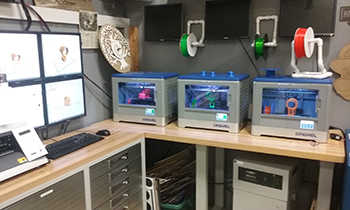3D Printing Expands Lakeview Technology Academy STEM Program
 Science, Technology, Engineering and Mathematics (STEM) education is no longer a novelty in schools; it’s the new norm. Today, traditional schools and specialized STEM academies alike regularly partner with STEM related firms to enhance their curriculum.
Science, Technology, Engineering and Mathematics (STEM) education is no longer a novelty in schools; it’s the new norm. Today, traditional schools and specialized STEM academies alike regularly partner with STEM related firms to enhance their curriculum.
Matthew Schultz is an engineering instructor at Lakeview Technology Academy in Pleasant Prairie, Wis., which receives support from a number of partner companies and organizations, resulting in a top quality STEM program. The school received three Dremel 3D printers from the company in particular to enhance its STEM makerspace.
Lakeview Technology Academy is located in a former industrial building that initially offered ample space, but a challenging layout. Schultz was able to design a new 24-student lab and classroom space in the back of the building that now includes a variety of hand and power tools, computers, a projector, sound electronics and white boards. The space aims to help students take their ideas from concept to reality, providing all the tools, materials and implements necessary to make any number of projects happen.
School Construction News spoke with Schultz about how he crafted his classroom, and how 3D printing has changed the way he teaches.
Q. How did you retrofit this industrial space to better facilitate STEM education?
Schultz: When [the school purchased] the building, there were no walls; it was just this big, open space. Slowly it started to be transformed into a school. My classroom itself was in a very small space. In the beginning, we had three-quarter walls that didn’t even go all the way to the ceiling. When you were running a drill or saw or doing any type of physical work in the lab it would just radiate throughout the whole building.
One whole wing of the classroom is now set up with all the manual shop tools. In the middle I have six lab tables that allow seating for four each, because most of the projects we do are group-based in teams of four. On the other side of the classroom I have a makerspace with three 3D printers given to us by Dremel with monitors above them so kids can…see the 3D printers printing live.
Q. What furnishings do you use in the classroom?
Schultz: The tables themselves are higher and sit about three feet off the ground. The chairs are swivel stools. Everything can fit under the desk because most of the time [students] are not sitting. Three-quarters of the lab is bordered in workbenches with permanent tools. On the other side I have maker/lab spaces with rolling carts and drawers underneath to fit all the supplies and hand tools. That is where the laser printer, 3D printers, etc. are located.
Q. How does the space support collaborative learning and problem solving?
Schultz: A lot of what I do and how I teach is a process-based education approach. I’ll teach students how to do a process, and then give them an avenue to actually explore that process with their own creative process. I’ll show them how to use [the available equipment and tools]; the output is based on their creativity. This classroom structure and the environment I create beyond the physical space is one of collaboration. The essence of a fabrication lab is not necessarily how many 3D printers you have or what kind of laser printer you have; it’s working in a community to solve a problem with the resources around you.
Q. Why are tools like 3D printers necessary to ensure quality STEM education, and how are your students using these devices?
Schultz: In my early days teaching…we would design [projects] on paper first. We weren’t even designing computer models at that time. Then, [students] would take the raw materials, cut them, sand them, join them together and things wouldn’t work; things wouldn’t line up. We really didn’t have time to go back and redesign. The prototype was the final product.
Now, with the 3D printer being available in the classroom, students are getting much earlier exposure to 3D rendering programs. Five years ago it wasn’t as common to see kids with those skills. Kids now know how to design something in a virtual space, test it and actually print it out. They’re now able to build the physical model, go to the computer, make changes and print it again. This process will happen up to three or four times to make it perfect, but in the past I could never go past this prototype stage. There was no time, no money; we just had to keep moving. Now it’s such a quick process that in two or three classes they might come up with two or three different models.
Also, the traditional shop is not appealing to every student. Another benefit to having these 3D printers is that it’s a safe way to approach engineering and problem solving. It allows other students that weren’t necessarily hands-on an opportunity to still be involved.
